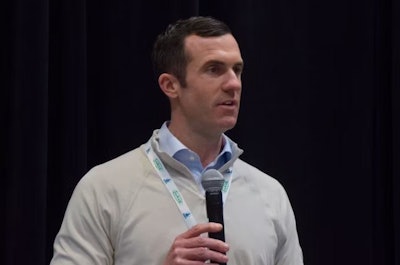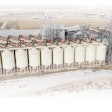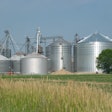
 Brett Buchanan, CFO, BCI
Steven Kilger
Brett Buchanan, CFO, BCI
Steven Kilger
Through their discussion, we learn how QR codes make it easier for customers to perform maintenance, access equipment documents, and improve safety and maintenance regimens.
This technology allows users to scan QR codes with their smartphones and access comprehensive information about the equipment, including maintenance procedures and safety guidelines.
Steven Kilger:Hello everyone! Welcome to theFeed & Grain Podcast, and thank you for listening. My name is Steven Kilger, managing editor for Feed & Grain and your host.
What a great show we have, Bret Buchanan, CFO of Bulk Conveyor Inc. (BCI), is my guest.
Today, we're talking about a cool technology BCI has where they're using QR codes on their equipment to make it easier for customers to perform maintenance on equipment and as a better way of organizing the documents and things you need for your equipment and can help with safety and maintenance regiments. It's cool the way they're using this technology that everyone has on their phone that they can use.
But before we get to all that, if you're listening to this podcast within a podcast app, please consider subscribing and if the podcast app allows you, leave a review. If you can't do that, though, you'll get updates on new episodes of the podcast on the daily Industry Watch Newsletter and also on our website feedandgrain.com.
So thank you again so much for listening. And onto our conversation with Brett. Hey, Brett. Thanks so much for joining me today.
Brett Buchanan, CFO, BCI:Anytime. Thanks for having me.
Kilger:I first wanted to have you on because I went to GEAPS Exchange in March, and you did aTech Talk about how you were using this QR code technology. I found it really interesting, in part because, before the pandemic, I thought QR codes were dead. The pandemic really brought him back with a vengeance.
Now you have this situation where everyone scanned a QR code coming in, and everyone knew how, which kind of blew my mind. It made me think how much easier this technology is to use than when it was first introduced. Can you explain to me a what you do at Bulk Conveyor Inc. and how you're using QR codes?
Buchanan: We're based out of Wichita, Kansas. We make heavy-duty HD chain conveyors and bucket elevators. All of our equipment primarily goes into processing facilities that are running 24/7, 365 days a year.
We saw a need for this QR technology. We were seeing maintenance managers either retire or people unfamiliar with positions or equipment. This platform gives our end customers an encyclopedia of that piece of equipment at their fingertips. We get quite a few calls where people need spare parts, or people need help tensioning the chain within the chain conveyor. With one scan of this barcode or QR code, that end user will be able to see every single aspect of how that piece of equipment works/operates, including maintenance, safety and more.
Kilger: It sounds great because there's nothing worse than having something that needs fixing on a piece of equipment then having to go find the manual, go to a website and try to find the info or call you guys. Can you tell me about the system itself? Because I believe it involves some kind of sticker you guys print out and put on the machine that goes into some kind of portal.
Buchanan:I think the hardest thing about it was just finding the right sticker. Again, our equipment is located in some pretty hot, severe environments. That was one of the trickiest things, just finding a sticker that has a 10- to 15-year life on our equipment.
一旦我们发现,我们建立了一个平台主机l the information within the sticker for the piece of equipment and, like you said, to go back on the drawings. The end user doesn't want to have to go back to the office once they're 200 feet in the air looking at a piece of machinery. We've come across quite a few customers who don't even know where the drawing is, so that's what we think is a value-add to the end user. They can use our equipment to its potential. Therefore, their facility is going to run much more smoothly, and their downtime is going to be minimized by them having the encyclopedia for that piece of equipment at their fingertips.
Kilger: It seems like such a small thing, but it's going to save so much time because, how many pieces does a facility really have? More than likely, they weren't all upgraded at the exact same time, so you might have slightly different models per line that you're running. It seems like it'd make the organization easier for maintenance specialists.
Buchanan:是的,它使组织更容易,它也confirms that you're ordering the right part. A lot of times, we'll get people that aren't familiar with the piece of equipment. You know, I think it's the sprocket or I think the head shaft is this size. Where with every piece of our equipment, it'll show the bill of material where there's no gray area when you're ordering spare parts. It lists every single spare item within that piece of equipment. Technically, you could take a picture of the QR code, hit the bill of material, then simply hit our phone number and order spare parts. We figure that within three to four clicks and less than 45 seconds, you can order the spare part for any piece of our equipment.
Kilger: Very cool. Is it just the current equipment you're putting out there? Or can people order stickers for older pieces of equipment?
Buchanan:Great question. A lot of our customers have seen the value, and we only came up with this a few years back. We had sold some equipment without this technology on it and will retrofit or send any of our current customers stickers for their existing equipment that basically was built before this came out.
Kilger:I think even at the Tech Talk you gave, a guy immediately brought that up. Let's face it, feed mills, grain facilities, they're not the nicest environments. They can get beat up quickly. But you can order replacement stickers easily if something happens to the one on your piece of equipment, right?
Buchanan:Correct. We do not charge for this. We want to sell our customers conveyors and equipment and bucket elevators, but we just felt like this is a value-add. The more successful our end users are, the more successful their operations are. It's free of charge, and we think it's a value-add that separates our equipment from the others.
Kilger:Do you have any examples of how the QR platform has been utilized by customers? Anything that they've done that you weren't really expecting them to do with the technology?
Buchanan:We've seen great success with operations and safety -- just the safety aspect of how to properly run it.
I previously mentioned about the spare parts, there's nothing worse than getting a spare part, and you're down and that spare part not being correct. We've had tremendous feedback on new maintenance managers switching locations. Knowing that in three clicks or four clicks, you're getting the right spare part.
One of our larger milling companies use it for a safety log. For example, if you were to tension the chain on June 5, 2023, they simply send us an email, and we go on the back end of the QR code and keep a maintenance tracking sheet for that piece of equipment. When you go back, you can see exactly when the chain was tightened within that chain conveyor.
Kilger:The safety aspects are a good point. The repair aspects are really obvious. You can see the exact part you need and order it, but keeping the safety information ... I imagine it's like the encyclopedia. So if someone needs to look up how to properly run this machine, they can do so just with a simple scan, right?
Buchanan:Exactly. It seems pretty elementary but just even having the ability to take a picture of the barcode and get our phone number or having the ability to hit one button and talk to a real person that actually works for the company and not a call center has been a big value-add to our customers.
Kilger:When you're in that situation where you need to call the company, you're already in a pretty stressful situation.
Buchanan:Exactly. People don't know what phone number to call. They don't know if this is the right company, so to have that assistance at your fingertips, it's a big help. That's the feedback we've received.
Kilger: As you said, it must be really nice for new employees, which there are quite a bit of as employees get stretched thinner and thinner. You might not have a maintenance guy on site anymore. He might be roaming between multiple facilities. Being able to exactly have someone go in and scan, that's really cool.
Buchanan:Another positive feedback is the ability to have the drawing to see it on your phone. Scan the QR code and have our drawing that has every aspect -- chain speed, shaft size and everything else -- where the employee that isn't familiar with a piece of equipment can become really familiar with it within a few minutes by looking at the drawing.
Kilger: It's an innovative way to use technology to make our lives at the plant easier. Thank you so much for coming on and chatting about it today. Do you have anything else you want to add? Anything we didn't cover?
Buchanan:No, I think that's about it. Listeners are more than welcome togive us a call. As I said, this comes out on every piece of chain conveyor and bucket elevator. We feel like it's a very good value-add. We get some of the best feedback and best ideas from our customers, so we're continually listening to see how we can improve our equipment and our process and just never settling for the status quo.
Kilger:That sounds great. Thank you so much for joining us and talking to everybody about what you have going on.
Buchanan: Anytime. I appreciate you having me on and have a great week.
Kilger:Yeah, you too. Thanks, everyone out there, for listening. Make sure you stay safe, and we'll see you next time.

.jpg?auto=format%2Ccompress&crop=faces&fit=crop&h=48&q=70&w=48)




















